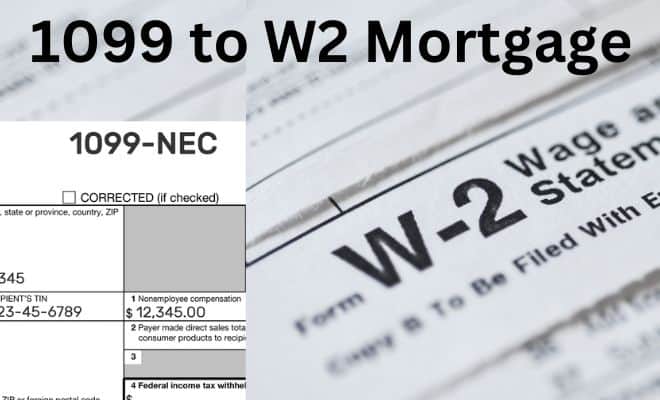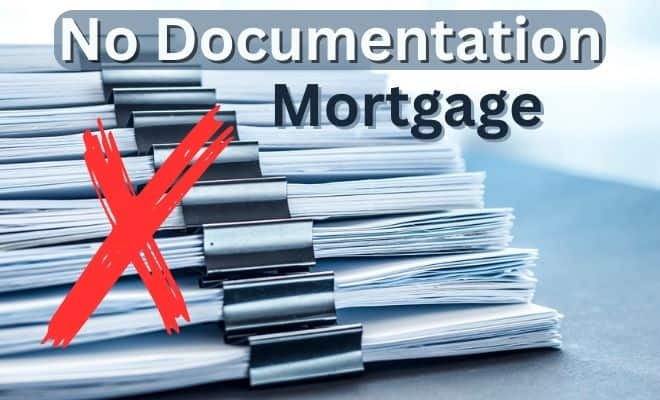1099 to W2 Mortgage Options for 2024
Transitioning from 1099 income to W2 can have a positive effect on your mortgage application. Lenders tend to favor stable income, which comes more assuredly from a W2 job as it often includes a steady employment history.
The unexpected twist here is that not only the amount of income matters; the source and stability are equally important in securing a mortgage. Now, it’s about understanding how they evaluate stability.
Transitioning from a 1099 self-employed status to a W-2 employee status for mortgage qualification typically involves securing consistent employment with a signed contract, regular hours, and payroll taxes withheld. Lenders often require at least two years of documented income as a W-2 employee for mortgage approval, so it’s essential to consult with professionals and consider potential financial and legal implications before making this transition.
Converting 1099 Income to W2 for Mortgages
Making the shift from 1099 income to W2 for mortgage purposes can be a significant transition, as lenders tend to favor applicants with stable income sources. One of the major challenges is most lenders may require you to have established a W2 job for at least two years. However, it can still be done without waiting.
One of the first steps in this process is evaluating the stability of your W2 income, which is beneficial for a successful mortgage application. Lenders want to see a steady employment history with a reliable W2 job, as this provides them with confidence that you have a consistent and predictable source of income.
Understand that many mortgage lenders value predictability and consistency in employment as it provides them with assurance that you will be able to meet your monthly mortgage payments without difficulty. Having a stable W2 income not only enhances your mortgage application but also lays the groundwork for your financial stability as a homeowner.
Additionally, once you have made the transition from 1099 to W2, thorough documentation of your employment status becomes key. This includes ensuring that your change in employment status is properly documented and communicated to your employer.
You may need to provide evidence such as offer letters, employment contracts, and pay stubs as documentation of your new W2 employment. These documents serve as proof of your employment status and income, providing the lender with the necessary reassurance regarding the stability and consistency of your earnings.
Clearly documenting your transition from 1099 to W2 employment provides lenders with the evidence they need to assess and verify your stable income, thereby strengthening your mortgage application.
The shift from 1099 to W2 has implications beyond mortgage applications; it shapes how you might enjoy certain benefits but also comes with its own set of challenges. Let’s turn our attention now to explore these considerations in detail.
Click to Speak with Someone About How to Qualify
Advantages and Disadvantages of W2 over 1099
Transitioning from 1099 to W2 can have numerous implications when it comes to securing a mortgage. Let’s first explore the advantages of W2 employment in this context.
Advantages
Stability: One of the key advantages of having W2 income is its perceived stability. Lenders often view W2 employees as having a more reliable and stable income compared to 1099 contractors. This sense of stability can work in your favor during the mortgage application process, assuring lenders that you have a consistent source of income to meet your mortgage payments.
Easier Income Verification: Another advantage of W2 income is the ease of income verification. For W2 employees, income verification typically involves providing pay stubs and W2 forms. This standardized documentation simplifies the mortgage application process, making it easier for lenders to verify your income and assess your ability to make regular mortgage payments.
The advantages of W2 employment are clear, but it’s important to consider the potential downsides as well. Let’s take a closer look at the disadvantages associated with W2 employment when applying for a mortgage.
Disadvantages
Limited Tax Deductions: Unlike 1099 contractors who have more flexibility with tax deductions, W2 employees have limited options for tax deductions. This limitation can impact the overall affordability of a mortgage, as individuals with 1099 income may have more opportunities to offset their taxable income through various business expenses and deductions. As a result, the lower taxable income of 1099 contractors may provide them with greater purchasing power when it comes to securing a mortgage.
Weigh these advantages and disadvantages carefully when considering the transition from 1099 to W2 employment, especially in the context of mortgage applications. While W2 employment offers stability and streamlined income verification, it may come with limitations on tax deductions that could impact your overall financial positioning during the mortgage approval process.
Bill Gasset, owner of Maximum Real Estate Exposure, offered his guidance and expertise.
From many years of being a real estate agent, working with a mortgage broker with significant experience under their belt has been invaluable for challenging mortgage situations. The advantage is having access to multiple lenders
As you know, brokers can help individuals find lenders more accommodating to their specific financial situation.
Seeking alternative lenders who specialize in working with borrowers with non-traditional employment situations makes it possible as they typically have more flexible underwriting criteria.
Another possibility worth exploring is government backed loans. Government-backed loans such as FHA (Federal Housing Administration) or VA (Veterans Affairs) may have less stringent income verification requirements. It makes them more accessible to individuals with non traditional employment situations.
The Mortgage Application Process for W2 Workers
When applying for a mortgage as a W-2 worker, your lender will want to see documentation proving your stable income. This ensures you have the capacity to make payments on time. The documents you may need include:
- Pay stubs: Showing how much money you earn and how often you are paid.
- W2 forms: A statement of your wages from the previous year.
- Employment verification letters: Proof of your employment status and income stability.
If you have just made the transition from 1099 to W2, you will need recent pay stubs and tax returns from the prior two years. Lenders will understand that you likely do not have W2s yet.
Income Stability Assessment
Once the lender has these documents, they will carefully examine them to assess your income stability. They want to see that you’re earning a consistent amount of money and that your employer is reliable. This is similar to how your boss might review your work to ensure you’re doing it well.
Lenders use this information to calculate your debt-to-income (DTI) ratio, comparing the amount of money you owe each month to the amount you earn. This helps them determine if you can handle additional financial responsibilities like a mortgage. When transitioning from 1099 to W2, changes in income and employment structure can affect this ratio, which could impact the approval of your mortgage application.
For example, if you were previously self-employed (1099 worker) and then switched to a W2 employee, lenders might require additional documentation to verify the stability of your new income. They will likely scrutinize tax returns from previous years when you were self-employed in order to understand your financial history and assess any potential risks associated with the transition.
It’s important for individuals in this situation to work with a knowledgeable lender or mortgage advisor who can guide them through the application process and help navigate any potential challenges. Each lender may have different requirements and criteria, so doing thorough research and comparing options before applying for a mortgage is crucial. Seeking professional guidance and preparing all required documents in advance can improve the chances of a successful mortgage application.
Navigating the mortgage application process as a W-2 worker involves providing evidence of your income stability and capacity to handle mortgage payments. Working closely with a lender or mortgage advisor who understands these requirements can greatly improve your chances of a successful application.
Determining Real Income for W2 Workers
When it comes to applying for a mortgage, accurately assessing the real income of W2 workers is crucial for lenders. This process involves analyzing various documents, such as pay stubs, W2 forms, and tax returns. Let’s take a closer look at these essential steps in determining real income.
First and foremost, pay stubs provide a detailed breakdown of an individual’s earnings. They typically include information about gross pay, taxes withheld, and net pay. Lenders carefully review pay stubs to verify the consistency of income over a specific period. This helps them establish the borrower’s ability to meet monthly mortgage payments.
Analyzing W2 Forms and Tax Returns
In addition to pay stubs, W2 forms play a pivotal role in assessing an applicant’s real income. These forms provide an overview of the individual’s earnings and taxes withheld throughout the year. Lenders scrutinize this information to gain a comprehensive understanding of the borrower’s financial situation. Furthermore, tax returns offer valuable insights into a borrower’s income stability and financial standing over time.
Lenders leverage these documents to evaluate the borrower’s gross income, which serves as a fundamental parameter in calculating the debt-to-income ratio.
For instance, if an individual has received bonuses or additional sources of income, such as commissions or overtime pay, this information should be readily evident on their tax returns. While a stable income trend is favorable, fluctuations could raise concerns during the underwriting process.
Lenders must consider a borrower’s debt-to-income (DTI) ratio—a critical metric that compares their gross income against their existing debts. This ratio plays a significant role in determining mortgage approval. Each type of mortgage has a maximum DTI ratio allowed per the guidelines, and lenders often impose their own limits.
Understanding how lenders calculate real income is pivotal in comprehending what factors contribute to your mortgage application’s success as a W2 worker.
Strategies for 1099 to W2 Transition
Transitioning from a self-employed 1099 worker to a W2 employee involves significant changes, both professionally and personally. Here are some strategies to help you navigate this transition smoothly and effectively.
Secure Stable Employment
Securing stable employment with a reputable company is crucial before making the leap from 1099 to W2 employment. This step may involve networking within your industry, actively searching for job openings, or leveraging existing professional connections.
It’s important to carefully evaluate potential employers and seek positions that not only offer stability but also align with your long-term career goals. Additionally, consider seeking opportunities with companies that provide comprehensive benefits packages, including health insurance, retirement plans, and paid time off.
Financial Planning
Transitioning from 1099 to W2 employment can have a significant impact on your financial situation. Therefore, it’s essential to engage in thoughtful financial planning to ensure a smooth and sustainable transition.
Part of this planning may involve creating a detailed budget that accounts for changes in income, taxes, and benefits. Moreover, considering the potential variation in pay frequency between self-employment and traditional employment, adjusting spending habits accordingly will be important. Many find it beneficial to build an emergency fund to cushion any financial challenges that may arise during the transition period. Seeking guidance from a trusted financial advisor can also provide valuable insights and strategies for optimizing your financial plan.
Setting up automatic contributions to a savings account can be an effective way to build an emergency fund gradually over time, providing a sense of financial security during the transition.
By securing stable employment and engaging in comprehensive financial planning, you can lay a strong foundation for a successful transition from 1099 self-employment to W2 employment.
Employee Benefits Impacts on Mortgage Applications
When applying for a mortgage, lenders want to see that you are financially stable and capable of making regular payments. Employee benefits play a crucial role in showcasing your financial stability and reliability.
For instance, health insurance is a significant employee benefit that can positively impact your mortgage application. Lenders view health insurance as an indicator that you have access to essential healthcare services without incurring significant out-of-pocket expenses. This can give lenders confidence in your ability to manage unexpected medical bills without defaulting on your mortgage payments.
Additionally, retirement plans such as 401(k)s and IRAs demonstrate long-term financial planning and responsibility. Lenders appreciate borrowers who actively prepare for their future by contributing to retirement accounts. These contributions reflect a commitment to financial stability, which can enhance your credibility as a mortgage applicant.
Moreover, consistent bonuses as part of your employment benefits can play a pivotal role. It showcases an additional source of income that can strengthen your financial profile and may be considered as an extra layer of security when evaluating your ability to handle mortgage payments.
The Impact of Employee Benefits
In summary, employee benefits contribute to the overall financial picture presented in your mortgage application. Health insurance, retirement plans, and bonuses collectively demonstrate your ability to manage both short-term and long-term financial obligations, providing lenders with confidence in your capacity to uphold the financial responsibilities associated with homeownership. It’s important to highlight these benefits when applying for a mortgage, as they can significantly influence the lender’s perception of your financial stability and creditworthiness.
With the groundwork laid for understanding how employee benefits play a critical role in mortgage applications, let’s now explore the collaborative efforts needed from employers and lenders to secure loan approval.
Collaborating with Your Employer and Lender for Loan Approval
When it comes to securing a mortgage, working closely with both your employer and lender can make a significant difference. It’s all about ensuring that everyone is on the same page and has the necessary information to support your mortgage application. This collaboration can entail various tasks, such as providing additional documentation, verifying your employment status, and addressing any specific requirements from the lender.
Why Collaboration is Important
Verifying Employment Status: Your lender will want to verify your employment status. They need to confirm that you are currently employed and receiving the income you’ve stated on your application. Your employer plays a key role in this verification process, as they may be required to provide employment verification documents directly to the lender. These documents typically include details about your job title, length of employment, and current salary.
Addressing Lender Requirements: Lenders often have specific criteria or requirements for borrowers seeking a mortgage. These requirements may pertain to minimum income thresholds, debt-to-income ratios, or other financial considerations. Collaboration between you, your employer, and the lender is essential to ensure that these requirements are met. For example, if there are particular documents or forms that the lender needs from your employer, it’s important to facilitate the exchange of information in a timely manner.
Providing Additional Documentation: In some cases, additional documentation related to your employment and income may be requested during the mortgage application process. This could include pay stubs, tax returns, or other financial records. Working closely with your employer to obtain these documents can help streamline the approval process and demonstrate your financial stability to the lender.
Working together with your employer and lender shows a unified front and helps build trust in your financial credibility as an applicant.
For instance, if you’re self-employed or have irregular income streams, collaborating with both parties becomes even more critical due to the nuanced nature of documenting income from non-traditional sources.
In essence, open communication and proactive collaboration between all parties involved can smooth out potential hurdles in the mortgage application process and foster a sense of mutual support as you work towards securing the loan needed for your new home.
Frequently Asked Questions
Do lenders view converted income from a 1099 to a W2 differently when considering mortgage applications?
Lenders do view converted income from a 1099 to a W2 differently when considering mortgage applications. The transition from 1099 to W2 shows a shift from self-employment to traditional employment, which lenders generally perceive as a more stable and reliable income source.
According to recent statistics, applicants with W2 income are more likely to be approved for mortgages compared to those with 1099 income due to the perceived consistency and predictability of W2 income.
How can I convert my income from a 1099 form to a W2 form?
Converting income from a 1099 form to a W2 form involves transitioning from being self-employed to working as an employee. To do this, you need to find employment with a company willing to hire you as a W2 employee and withhold taxes on your behalf.
According to statistics from the Bureau of Labor Statistics, in 2023, 43% of workers in the United States were classified as independent contractors or self-employed. The decision to make this transition should be based on factors such as job stability, benefits, and tax implications.
Are there any specific requirements or guidelines for obtaining a mortgage with converted income?
Yes, there are specific requirements and guidelines for obtaining a mortgage with converted income. Lenders typically require borrowers to have a stable employment history with at least two years of documented W2 income. However, there may be some flexibility for individuals who have recently transitioned from 1099 to W2 income, as long as they can demonstrate consistent and reliable income in their new position.
What is the difference between a 1099 form and a W2 form?
The main difference between a 1099 form and a W2 form lies in the employment status. A 1099 form is used for independent contractors or self-employed individuals who receive income from various sources, while a W2 form is issued to employees who work for a single employer. The impact of this transition on mortgage applications is significant as lenders often require consistent income documentation, stability, and proof of employment.
According to recent statistics, there has been an increase in mortgage application rejections due to the shift from 1099 to W2 status, highlighting the importance of understanding this transition for potential borrowers.
Can I qualify for a mortgage with only 1099 income?
Yes, it is possible to qualify for a mortgage with only 1099 income. Lenders may consider alternative documentation such as tax returns and bank statements to verify income stability and repayment capacity. However, it is important to note that qualifying for a mortgage solely based on 1099 income can be more challenging compared to having W2 income, as lenders typically prefer steady employment and consistent income.
According to the Mortgage Bankers Association, self-employed individuals accounted for about 14% of all mortgage applications in 2023, indicating that lenders are becoming more flexible in accommodating different types of income sources.





